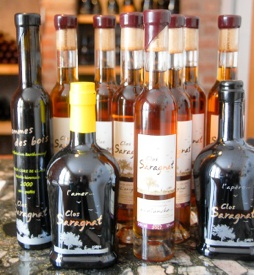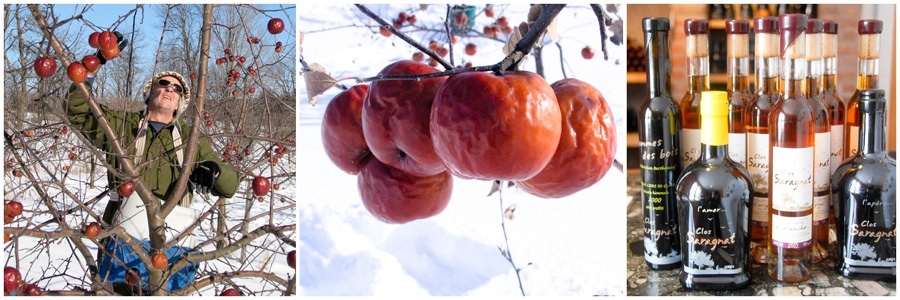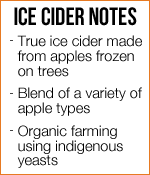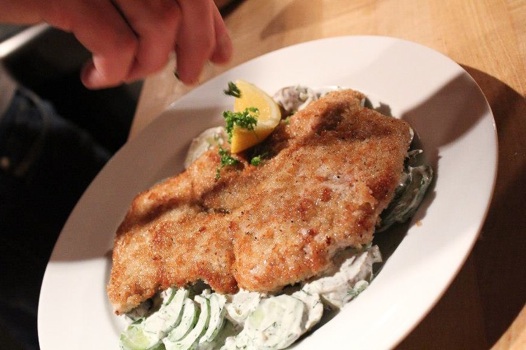Clos Saragnat, Cider, Ice Cider, Christian Barthomeuf, Cider Maker, Canada, Canadian, Quebec, Frelighsburg, Where to eat, cider recommendations, restaurants


Christian Barthomeuf is the pioneer of ice cider (cidre de glace) production. He makes small scale, organic alcoholic cider, by fermenting the juice of apples that have been left to freeze in frigid Quebec.
Sommelier Etheliya Hananova talks to Christian about the unique production of true ice cider, what to pair it with and some of his favorite eating spots around the world.
Clos Saragnat Ice Cider
March 30, 2011

Cider Maker Christian Barthomeuf
Q & A With Christian Barthomeuf Of Clos Saragnat

Q. What is the history of ice cider in Quebec?
A. I’m the history of ice cider; it didn’t exist before I started making it.

A. I’m an artist at heart; I’m self-taught. I planted my first grapevines in 1980, and I was literally working out of a manual. My first wine was produced in 1982.
I was motivated until I came to the point where I realized that if I was to commercialize wine, I’d be competing with an international market and that would be really hard with our cold climate. Since I had no desire to move somewhere like Chile to make wine, I thought about trying to produce Quebec ice wine. However, as I was thinking that getting grapes to grow properly here is very difficult, I was struck with the idea of making ice cider instead, using the same methods of production.
Q. Is there ice cider production outside of Quebec?
A. I know there is some made in Vermont and possibly in Ontario.
Q. Why is it particularly suited to this province?
A. Basically, the most important thing is to have freezing temperatures in the winter.
Q. If freezing temperatures are so important, are you worried about climate change?
A. I’m definitely concerned. In a year with ideal conditions, production can be as high as 8,000 bottles. In December of 2006 there were only two days below freezing temperatures, and in January of 2007, temperatures climbed up to 20° celsius [68 degrees]; people were playing golf. My production was down to about 1,500 bottles in 2006. Who knows how things will go in 10-15 years?
Q. There are two possible methods of freezing the apples (some ice cider producers pick the sugar-concentrated apples late into the autumn and put them into freezers). Why have you chosen to go with freezing the apples on the trees?
A. It’s not really ice cider if you’re not picking the apples frozen off of the trees. It’s sweet cider, but not ice cider. We’re working towards stricter legislation here in Quebec to ensure that production is carried out properly and that people who are not using the real methods of producing ice cider can’t market it as such. As far as I’m concerned, if the apples are frozen in a freezer, rather than naturally on the branches, it’s not ice cider.

A. I never wanted to use conventional varieties of apples, such as Macintosh and Lobo; those are easy, flavorful, and straightforward. Some of my apples are bitter, some sweet, some very acidic, and I blend the resulting ciders to find the right balance.
Since the beginning, I have been using strange varieties whose names we don’t even necessarily know. I had someone give me two apple trees from a forest in New Brunswick recently; the apples were good, so I put rootstocks on them, planted them, and named the variety after him (François). I’ve named several of the varieties in the orchard after people; there are varieties named Loulou and Madame Langevin.
I get the apples from all over the place; some grow wild in the forest, some are given to me. Some of these trees have been here since before the settlers came, they’re very hardy and resistant. Basically, my two criteria is that the apples stay on the branches long enough to freeze in winter, and that they be resistant to disease because I refuse to spray or use chemicals.
Q. You have chosen to work organically in the orchard. What does that mean in terms of working with apple trees and how does that continue to apply in the cider-making process?
A. I’ve been using indigenous yeasts found on the apple skins for fermentation since the beginning. I’ve never, ever used selected yeasts for my own production at Saragnat. That’s why it’s important for me to use organic methods. The most productive natural yeasts get killed off when the apples are chemically treated. I keep the continuum of the old yeasts by leaving some from previous vintages’ production for each new vintage. This requires vigilance and lots of care, but this is what gives the complexity and depth to the ciders.
As for the fermentation and the maturing of the ciders, I always work with stainless steel, never oak. I want the fruit to speak for itself without the oak influence.
Q. You still grow vines, hardier hybrid varietals that are suited to the cooler climate. Why?
A. I do have vines, but it’s really more for my own amusement at this point. I have some Vidal, some New York Muscat, and even some Gamay.
The one thing I do produce for sale is a vin de paille (straw wine, a style of wine often associated with the Jura region in France). Last year, however, the climate didn’t cooperate, so I didn’t produce a vintage.
Q. How is ice cider seen locally? Is there a market abroad?
A. Locally, it’s viewed with a sense of pride. It’s a double-edged sword, though, because as people discover it and get excited about it, others see it as something with lucrative potential, and since for the moment, we don’t have any solid legislation to control how it is produced, people who are less scrupulous might be inclined to take advantage of the opportunity to cash in without the commitment to proper production. That’s also a challenge in terms of export. If someone in Spain, for example, gets a hold of a sample of something that isn’t really representative of true ice cider, they’re going to think that that’s what it is like.
Q. Is this work something you see being carried out by future generations?
A. I don’t have children, so we’ll see how it all plays out. For the moment, Louise and I do everything, from the work in the orchards and in the cellar to the administration and marketing.
Q. Have you always lived in Quebec?
A. No, I’m originally from France, from the Massif Centrale, near the volcanoes. I came to Quebec 35 years ago (I followed a girl), and I’ve lived here ever since.
Q. In what context should ice cider be consumed? Are there any pairings you’d suggest?
A. It’s great on its own as dessert. It also pairs beautifully with certain cheeses. Some would say foie gras, but I’m a peaceful guy and I like ducks.
Recommendations

I’ve travelled extensively. Traveling was a big part of the master plan, and we’ve managed to go all over the place; Laos, Thailand, Mauritius, Turkey, South America... it hasn’t just been France and Italy. Next stop is 5 weeks in Sicily; we’re going to hike all around Etna and we’ll visit some vineyards along the way.

Restaurant August in Quebec
Photograph courtesy of Restaurant August
Quebec
Restaurant August
It’s a great high-end restaurant where you can just as easily stop in for a plate of boudin or gratin Dauphinois. And they have a great wine list.
82 Rue Wellington Nord, Sherbrooke, QC J1H 5A9, Canada
T: 819.565.9559 | www.auguste-restaurant.com
Tintoretto
They have the best scones I've ever had, both sweet and savory.
20 Principale N, Sutton, QC J0E 2K0, Canada
T: 450.538.2207
Milan
Pizzeria Grand’Italia
They only serves slices, but the best I’ve ever tasted. Dozens of types of pizza, from the classics to more adventurous and yet delicious combinations. A really great lunch option.
Via Palermo, 5, Milan 20121, Italy
T: +39.(0)2.877.759
Turkey
Obur Manti
A small family operation, where each member of the family is involved in the service and the cooking. The best service I’ve had in my life. Delicious turkish specialities, good portions and beautiful presentation.
5 Kibris Caddesi, Sinop, Turkey
T: +90.368.260.3816 | www.oburmanti.com
Vietnam
Le Bistrot
In Hanoi and they have things like pizza, steak frites and maple syrup crêpes. It’s in the middle of rural Vietnam, near an old airstrip used by the American airforce during the Vietnam war and run by a Quebecker. It was very refreshing to be in the middle of foreign land and suddenly have someone speaking Quebec French.
64 Nguyen Luong Bang Street, Dong Da, Hanoi, Vietnam
T: +856.85.14070
Laos
Roots and Leaves
It's a restaurant at the edge of a pond, surrounded by coconut trees and fruit trees of which the only ones I could identify were the mango trees. The food is amazing: Asian food that is explosive with flavor and visually stunning. The prices are reasonable, the service was perfect. There were also shows two or three nights a week. The natural jungle environment was incredible.
We were on the edge of a pond and in spite of the fact that we were technically in the city, the only sounds we heard were the cries and songs of birds, while the scent of grilled meats wafted in the air. The wines were very expensive, but this kind of cuisine is actually best suited to beer, and Laos beer is good and inexpensive. In any case, this isn't really wine country and when we travel, we're inclined to do as the locals do. Luang Prabang is a city not to be missed in travels in the region; it's a must visit place that we reached after 350 km. of speed boating on the Mekong. An unforgettable experience.
Setthathilath Road, Luang Prabang, Laos
T: +856.71.254870 | www.rootsinlaos.com
Get More Recs

Download the F.E.D. iPhone app and get more recommendations from chefs, sommeliers and bartenders.
Interviewed By ETHELIYA HANANOVA
Photographs courtesy of Clos Saragnat



Share


General Information

Clos Saragnat
Quebec
Ice Cider
100 Chemin Richford
Frelighsburg, QC J0J 1C0
T: 450.298.1444
Website:
Share





















